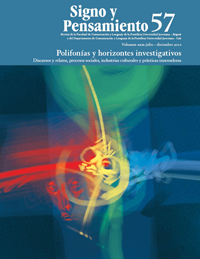Abstract
This article presents the results of a research work that aimed a comprehensive explanation of the way in which the meanings of the ‘Gaitanista’ discourse (1928-1948) were and are construed in Colombia from a corpus of texts compiled via three selection criteria: 1. Subjectivizing voice: texts produced by spokepersons that publicly express their intellectual adherence to the ‘Gaitanista’ movement. 2. Objectivizing voice: historiographic texts characterized by their claim to be scientific truth. 3. Polyphony of voices: texts characterized by their inclusion of diverse voices. The theoretical approach was based on a cross between communication as mediation (Martín-Barbero, 2003) and hegemony theory (Laclau, 2005).
Alape, A. (1985), El Bogotazo: memorias de un olvido, 3.a ed., Bogotá, Planeta.
Anderson, B. (2000), Comunidades imaginadas. Reflexiones sobre el origen y la difusión del nacionalismo, Buenos Aires, Fondo de Cultura Económica.
Ayala Diago, C. A.; Casallas Osorio, O. J., y Cruz Villalobos, H. (eds.) (2009), Mataron a Gaitán: 60 años. Cátedra Jorge Eliécer Gaitán, Bogotá, Editorial Universidad Nacional de Colombia.
Bonilla, J. I. (2002, julio-diciembre), “¿De la plaza pública a los medios de comunicación? Apuntes sobre medios de comunicación y esfera pública”, Signo y Pensamiento, núm. 41, vol. XXI, Facultad de Comunicación y Lenguaje, Pontificia Universidad Javeriana, pp. 82-89.
Braun, H. (2007), Mataron a Gaitán. Vida pública y violencia urbana en Colombia, 2.a ed., Bogotá, Aguilar.
Bushnell, D. (2000), Colombia una nación a pesar de sí misma, Bogotá, Planeta.
Chartier, R. (1992), El mundo como representación. Estudios sobre historia cultural, Barcelona, Gedisa.
Eco, U. (1968), Apocalípticos e integrados ante la cultura de masas. Palabra en el tiempo, Lumen, Barcelona.
González Lapuente, A. (2003), Diccionario de la música, Madrid, Alianza.
Gramsci, A. (1975), Notas sobre Maquiavelo, sobre la política y sobre el estado moderno, México, Juan Pablo.
Lacan, J. (1977), Los cuatro principios fundamentales del psicoanálisis. Seminario XI, Barcelona, Barral.
Laclau, E. (2002), Misticismo retórica y política, Buenos Aires, Fondo de Cultura Económica.
— (2005), La razón populista, Buenos Aires, Fondo de Cultura Económica.
Laclau, E. y Mouffe, C. (1987), Hegemonía y estrategia socialista, Madrid, Siglo XXI.
Magrini, A. L. (2010), De la narrativa al discurso. Un análisis de las narrativas, voces y sentidos de el discurso gaitanista en Colombia (1928-1948) [tesis de Maestría en Comunicación], Bogotá, Pontificia Universidad Javeriana.
Martín-Barbero, J. (1978), Comunicación masiva, discurso y poder, Quito, Época.
— (2003), De los medios a las mediaciones. Comunicación, cultura y hegemonía, Bogotá, Convenio Andrés Bello.
Marx, C. (2000), El capital, tomo i, México, Fondo de Cultura Económica.
Osorio Lizarazo, J. A. (1998) [1952], Gaitán, vida muerte y permanente presencia, 3.a ed., Bogotá, El Áncora Editores.
Pécaut, D. (2001), Orden y violencia. Evolución sociopolítica de Colombia entre 1930 y 1953, Bogotá, Norma.
Ricoeur, P. (2004), Tiempo y narración I. Configuración del tiempo en el relato histórico, México, Siglo XXI.
Schmitt, C. (1984), El Concepto de lo político, Buenos Aires, Folios Editoriales.
Zizek, S. (2005), El acoso de las fantasías, Buenos Aires, Siglo XXI.
This journal is registered under a Creative Commons Attribution 4.0 International Public License. Thus, this work may be reproduced, distributed, and publicly shared in digital format, as long as the names of the authors and Pontificia Universidad Javeriana are acknowledged. Others are allowed to quote, adapt, transform, auto-archive, republish, and create based on this material, for any purpose (even commercial ones), provided the authorship is duly acknowledged, a link to the original work is provided, and it is specified if changes have been made. Pontificia Universidad Javeriana does not hold the rights of published works and the authors are solely responsible for the contents of their works; they keep the moral, intellectual, privacy, and publicity rights.
Approving the intervention of the work (review, copy-editing, translation, layout) and the following outreach, are granted through an use license and not through an assignment of rights. This means the journal and Pontificia Universidad Javeriana cannot be held responsible for any ethical malpractice by the authors. As a consequence of the protection granted by the use license, the journal is not required to publish recantations or modify information already published, unless the errata stems from the editorial management process. Publishing contents in this journal does not generate royalties for contributors.


